Cisco has updated the product line of video communications equipment
Most recently, at Enterprise Connect 2014 in Florida, Cisco announced a full upgrade of its line of video terminal equipment. For those who missed this event, I prepared a brief overview of new products.
First of all, the 1st generation of the MX200 and MX300 systems is being supplanted by the 2nd generation of these devices - the MX200G2 and the MX300G2. I think anyone who compares the characteristics and price of these systems will make a choice in favor of the 2nd generation. This is not to mention the new design "arctic style" and the new 10 inch touch control panel.
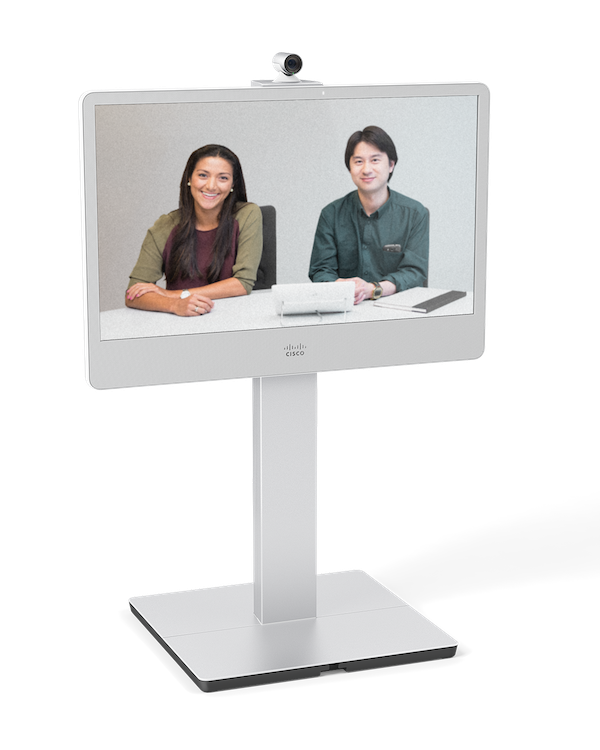
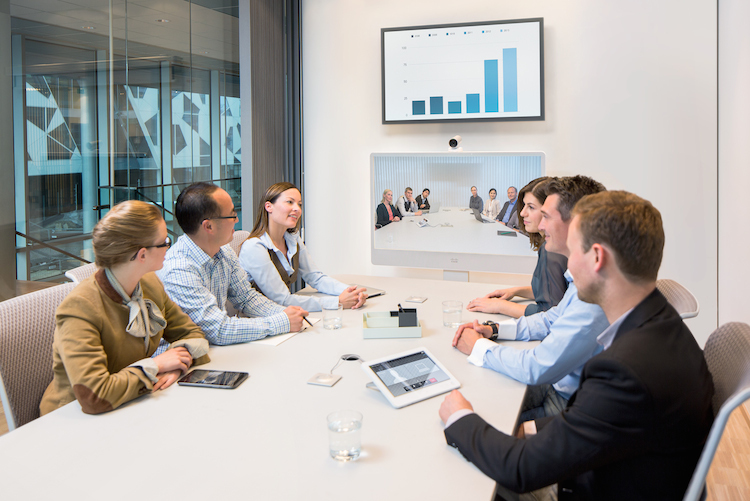
As for the comparison, I have summarized the main characteristics of the devices in one table. As they say, comments are superfluous.

')
Next - 2 new codecs of the SX line are announced - the simplest and low-budget - SX10 and the new top-end integration codec SX80.
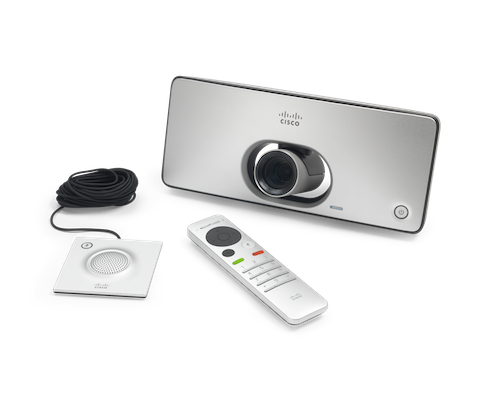
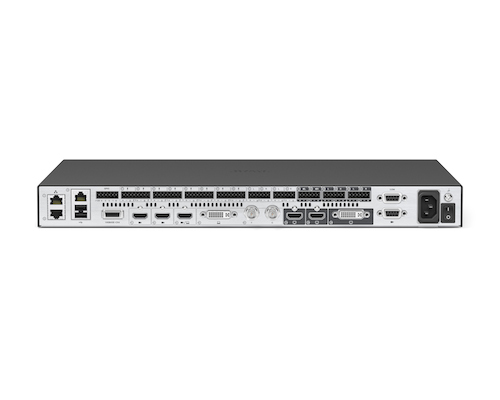
Thus, now we can talk about the new line of VCS codecs from Cisco - the SX line (SX10, SX20, SX80). It is too early to consider it as a complete replacement for the C-codecs (C40, C60, C90), but the C-series obviously goes to the 2nd place.
A new series of video systems raises the lower bar for video quality at 1080p30 and 1080p60 (starting with SX20). New company policy - working with maximum quality is available in the basic equipment configuration (previously it was a separate paid option). This also applies to the option of working with the second screen (for SX20 and SX80).
I am very glad that those who have already purchased the SX20 are not forgotten either. For them, it is now possible to add additional PR and DD options for the price “0”.
The SX10 becomes the most inexpensive codec in the terminal equipment line, displacing the SX20 kit with a 2.5-fold (now this is 5x times - thanks to the added 2x digital zoom) camera. However, one should not forget that the SX20 platform has significantly greater performance.
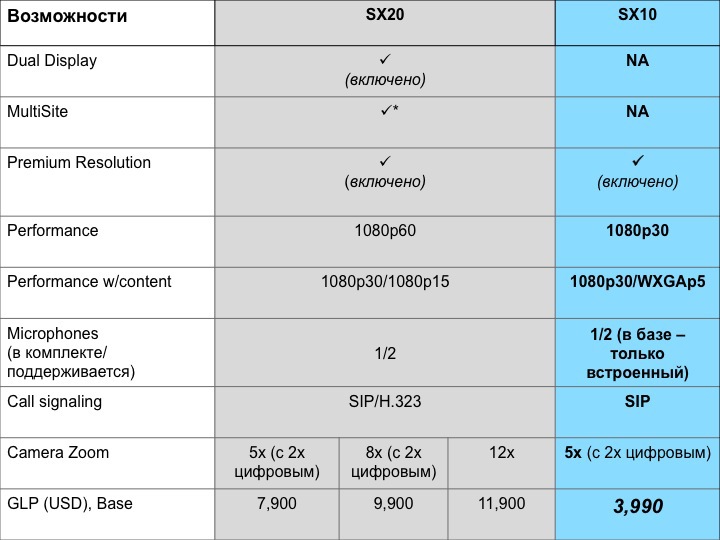
Despite some lagging behind the older brothers in their technical characteristics, we hope that the SX10 will be in demand in the market. With the release of SX10 - the company creates a new niche: "semi-professional video conferencing." The SX10 is designed for operation and maintenance by an untrained user. The new TRC6 console - does not allow making changes to the system settings (this can only be done administratively - via the WEB interface, or the configuration templates of the management infrastructure). For convenience of setup, a special initial installation wizard has been created that allows you to start the system by answering a few questions on the initial configuration screens. SX10 application area - small studios for 2-8 people. It is ultra-compact and easy to mount on the wall (mount included) or on VESA TV mounts (optional).
Now let's take a look at the SX80 - a truly revolutionary codec in both architecture and performance.
For the first time, Cisco abandoned the classic DSP architecture in favor of a multicore CPU based architecture. The “heart” of the codec is a 36 core processor from the Tilera company - TileGx36, operating at a frequency of 1.5 GHz. It is the CPU architecture that is the highlight of the codec - thanks to it, we already managed to implement support for the h265 protocol or HEVC (I remind you that it has not yet been ratified by ITU-T, so the developers were guided by a preliminary version of the standard. Considering that the encoding / decoding is implemented programmatically, after the final adoption of the standard, it will be possible to eliminate the possible discrepancy by changing the program code of the corresponding software modules).
According to the developers, the performance of 36 cores is enough to encode and decode at least 4 h264 video streams 1080p60, simultaneously with peripheral maintenance, audio stream processing and encryption processes. When using h265, the performance is only enough to encode and decode one 1080p30 stream. However, the gain is significant - h265 requires exactly 2 times less bandwidth, compared to h264.
For connectivity options, the SX80 is between the C60 and C90 -
Video inputs: 3 x HDMI + DVI-I + SD; Video Out: 2 x HDMI + DVI-I;
Audio: Microphone (with a signal line - 8, line inputs - 4, HDMI (audio input) - 3 (stereo), line outputs - 6, HDMI (audio output) - 2 (stereo).
+ 3 x Gigabit Ethernet, 2 x DB9 for connecting cameras using serial connection via VISCA protocol and control, 2 x USB and 10Gb Ethernet (for future use), GPIO (4-channel block of "dry contacts").
I would like to note the improved functionality of the built-in audio mixer, comparable in its capabilities with professional audio processors. Video mixing (compositing), as in the older C-series codecs, is also supported.
For those who want to use the new self-guided two-camera system, the Cisco Speaker Track 60 - the integrator kit with the SX80 codec (CTS-SX80-IPST60-K9) is the cheapest option (GPL $ 30,500).
Updated and line of large studio systems. True, the new systems are not assigned to the Profile series, but supplemented the MX series with the MX700 (two 55-inch screens) and the MX800 (one 70-inch screen).


Both systems can be ordered with one or two cameras (The configuration with two cameras supports the homing function. It is this configuration that is shown in the pictures).
The MX700 and MX800 are based on the SX80 codec (it is located in a niche on the rear panel), so there’s no point in describing their characteristics in detail - they repeat the characteristics of the SX80, their cost is the same - $ 4,9900 GPL. Considering that all options, except for the option of activating the built-in multipoint conferencing server, are now included in the basic configuration - they have dropped in price relatively commensurate with the Profile.
And finally, two personal video systems - there are simply no competitors on the market!
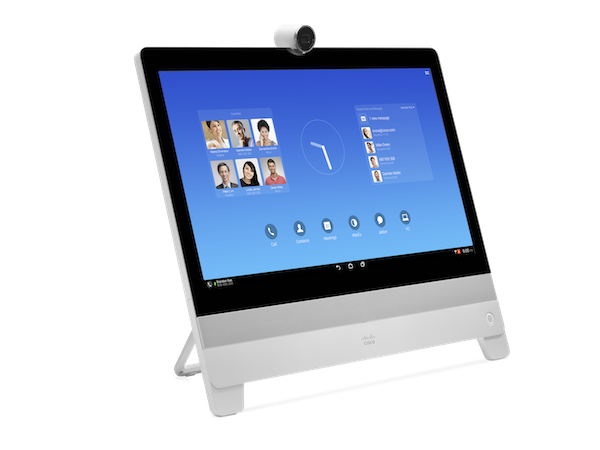
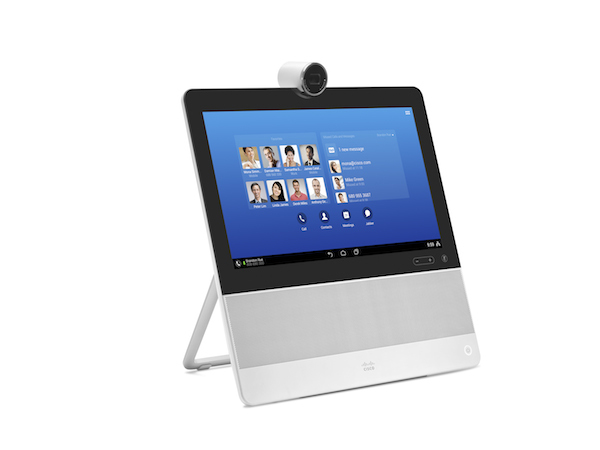
The DX80 and DX70 continue the lineup started by the DX650, and are a large and “advanced” version of the lower-end model.
Just like the DX650, they run the Android operating system version 4.1 and only with Cisco CallManager. In addition to large-sized touch screens, the new systems have support for receiving / transmitting content via BFCP, the HDMI input, VESA mount and cameras with support for switching to the “documentary” mode are used to connect the PC.
DX70 and 80 are not equipped with handsets (it is recommended to use the handsets or headsets of our partners - Jabra and Plantronics), so for comfortable use of the loudspeaker mode they support new technologies for working with sound: “Anti-Shading” - two microphone arrays allow you to choose the optimal route for receiving sound, even if there are obstacles between the microphones and the speaker (cup of coffee, laptop, etc.); “Privacy mode” - mode of suppressing sounds coming from zones outside the field of view of the camera (required when working in openspace); “Active Noise Reduction” - suppresses background noise (for example, noise from an air conditioning system).
Another interesting feature is the possibility announced for the DX80 to use its screen as an input device for a PC, under the control of operating systems with touch screen support.

On new systems, you can talk endlessly, but as they say - it is better to see one (or several) times.
Links to videos showing the new systems in the work below:
All new solutions in one short story: www.youtube.com/watch?v=H3R7KWYmHYg
DX70 and DX80 personal systems: www.youtube.com/watch?v=uhU3bSLPnIE
MX700 and MX800: www.youtube.com/watch?v=SJPKtfGf98A
SX10: www.youtube.com/watch?v=1Wnaj5QVK0k
SpeakerTrack 60 demo: www.youtube.com/watch?v=_nzmEf_1gyI
First of all, the 1st generation of the MX200 and MX300 systems is being supplanted by the 2nd generation of these devices - the MX200G2 and the MX300G2. I think anyone who compares the characteristics and price of these systems will make a choice in favor of the 2nd generation. This is not to mention the new design "arctic style" and the new 10 inch touch control panel.


As for the comparison, I have summarized the main characteristics of the devices in one table. As they say, comments are superfluous.

')
Next - 2 new codecs of the SX line are announced - the simplest and low-budget - SX10 and the new top-end integration codec SX80.


Thus, now we can talk about the new line of VCS codecs from Cisco - the SX line (SX10, SX20, SX80). It is too early to consider it as a complete replacement for the C-codecs (C40, C60, C90), but the C-series obviously goes to the 2nd place.
A new series of video systems raises the lower bar for video quality at 1080p30 and 1080p60 (starting with SX20). New company policy - working with maximum quality is available in the basic equipment configuration (previously it was a separate paid option). This also applies to the option of working with the second screen (for SX20 and SX80).
I am very glad that those who have already purchased the SX20 are not forgotten either. For them, it is now possible to add additional PR and DD options for the price “0”.
The SX10 becomes the most inexpensive codec in the terminal equipment line, displacing the SX20 kit with a 2.5-fold (now this is 5x times - thanks to the added 2x digital zoom) camera. However, one should not forget that the SX20 platform has significantly greater performance.

Despite some lagging behind the older brothers in their technical characteristics, we hope that the SX10 will be in demand in the market. With the release of SX10 - the company creates a new niche: "semi-professional video conferencing." The SX10 is designed for operation and maintenance by an untrained user. The new TRC6 console - does not allow making changes to the system settings (this can only be done administratively - via the WEB interface, or the configuration templates of the management infrastructure). For convenience of setup, a special initial installation wizard has been created that allows you to start the system by answering a few questions on the initial configuration screens. SX10 application area - small studios for 2-8 people. It is ultra-compact and easy to mount on the wall (mount included) or on VESA TV mounts (optional).
Now let's take a look at the SX80 - a truly revolutionary codec in both architecture and performance.
For the first time, Cisco abandoned the classic DSP architecture in favor of a multicore CPU based architecture. The “heart” of the codec is a 36 core processor from the Tilera company - TileGx36, operating at a frequency of 1.5 GHz. It is the CPU architecture that is the highlight of the codec - thanks to it, we already managed to implement support for the h265 protocol or HEVC (I remind you that it has not yet been ratified by ITU-T, so the developers were guided by a preliminary version of the standard. Considering that the encoding / decoding is implemented programmatically, after the final adoption of the standard, it will be possible to eliminate the possible discrepancy by changing the program code of the corresponding software modules).
According to the developers, the performance of 36 cores is enough to encode and decode at least 4 h264 video streams 1080p60, simultaneously with peripheral maintenance, audio stream processing and encryption processes. When using h265, the performance is only enough to encode and decode one 1080p30 stream. However, the gain is significant - h265 requires exactly 2 times less bandwidth, compared to h264.
For connectivity options, the SX80 is between the C60 and C90 -
Video inputs: 3 x HDMI + DVI-I + SD; Video Out: 2 x HDMI + DVI-I;
Audio: Microphone (with a signal line - 8, line inputs - 4, HDMI (audio input) - 3 (stereo), line outputs - 6, HDMI (audio output) - 2 (stereo).
+ 3 x Gigabit Ethernet, 2 x DB9 for connecting cameras using serial connection via VISCA protocol and control, 2 x USB and 10Gb Ethernet (for future use), GPIO (4-channel block of "dry contacts").
I would like to note the improved functionality of the built-in audio mixer, comparable in its capabilities with professional audio processors. Video mixing (compositing), as in the older C-series codecs, is also supported.
For those who want to use the new self-guided two-camera system, the Cisco Speaker Track 60 - the integrator kit with the SX80 codec (CTS-SX80-IPST60-K9) is the cheapest option (GPL $ 30,500).
Updated and line of large studio systems. True, the new systems are not assigned to the Profile series, but supplemented the MX series with the MX700 (two 55-inch screens) and the MX800 (one 70-inch screen).


Both systems can be ordered with one or two cameras (The configuration with two cameras supports the homing function. It is this configuration that is shown in the pictures).
The MX700 and MX800 are based on the SX80 codec (it is located in a niche on the rear panel), so there’s no point in describing their characteristics in detail - they repeat the characteristics of the SX80, their cost is the same - $ 4,9900 GPL. Considering that all options, except for the option of activating the built-in multipoint conferencing server, are now included in the basic configuration - they have dropped in price relatively commensurate with the Profile.
And finally, two personal video systems - there are simply no competitors on the market!


The DX80 and DX70 continue the lineup started by the DX650, and are a large and “advanced” version of the lower-end model.
Just like the DX650, they run the Android operating system version 4.1 and only with Cisco CallManager. In addition to large-sized touch screens, the new systems have support for receiving / transmitting content via BFCP, the HDMI input, VESA mount and cameras with support for switching to the “documentary” mode are used to connect the PC.
DX70 and 80 are not equipped with handsets (it is recommended to use the handsets or headsets of our partners - Jabra and Plantronics), so for comfortable use of the loudspeaker mode they support new technologies for working with sound: “Anti-Shading” - two microphone arrays allow you to choose the optimal route for receiving sound, even if there are obstacles between the microphones and the speaker (cup of coffee, laptop, etc.); “Privacy mode” - mode of suppressing sounds coming from zones outside the field of view of the camera (required when working in openspace); “Active Noise Reduction” - suppresses background noise (for example, noise from an air conditioning system).
Another interesting feature is the possibility announced for the DX80 to use its screen as an input device for a PC, under the control of operating systems with touch screen support.

On new systems, you can talk endlessly, but as they say - it is better to see one (or several) times.
Links to videos showing the new systems in the work below:
All new solutions in one short story: www.youtube.com/watch?v=H3R7KWYmHYg
DX70 and DX80 personal systems: www.youtube.com/watch?v=uhU3bSLPnIE
MX700 and MX800: www.youtube.com/watch?v=SJPKtfGf98A
SX10: www.youtube.com/watch?v=1Wnaj5QVK0k
SpeakerTrack 60 demo: www.youtube.com/watch?v=_nzmEf_1gyI
Source: https://habr.com/ru/post/225849/
All Articles